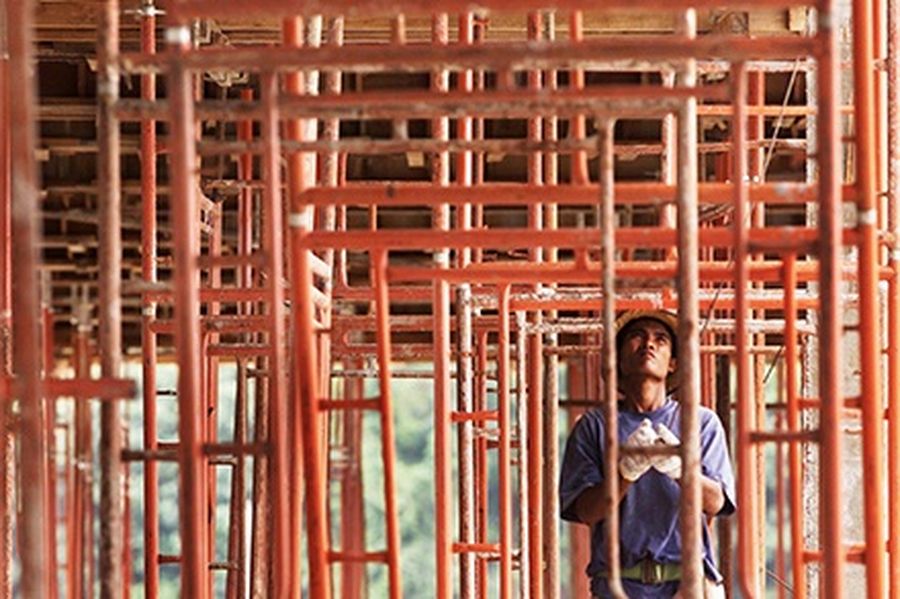The sukuk market stands to have another banner year, but inconsistent structures and a lack of liquidity continue to create roadblocks for Islamic debt.

Set for Growth
Source: REUTERS/Bazuki Muhammad
A worker prepares scaffolding at a construction site in Kuala Lumpur.
Sharia-compliant offerings out of Asia this year are expected to top last year’s total as global economic growth gathers steam, as the Islamic banking deposit base grows and as regional insurers and pension funds look to put healthy fund inflows to work.
Still, the Islamic debt markets will only rival conventional debt markets if bankers address perennial concerns about the market’s lack of secondary liquidity and the inconsistency over how deals are structured.
The purpose of Islamic debt is to offer a way for issuers to raise funds without paying investors interest, which Sharia law prohibits. Sukuk investors instead receive a return on an underlying asset. No universal structure or universally accepted standard for sukuk issuance has emerged, however.
Market participants have, for some time, hoped that sukuk issuance could overcome such hurdles to become a mainstream debt asset class, particularly in Asia where Islamic debt could help finance needed infrastructure projects.
Yet, the dominant issuers in the Asian sukuk market remain those from Malaysia and sovereign and sovereign-related entities able to sell bonds at the upper reaches of the credit curve.
One reason potential Islamic debt issuers have avoided issuing sukuk bonds is the all-in costs are higher than for selling conventional debt. Potential issuers are also wary of the documentation process involved in sukuk issues, perceived as complex and lengthy. In addition, they do not want to tie up underlying assets to meet the necessary requirements of Shariah-compliant offerings.
Asian sukuk bonds have been issued in several currencies, including US dollars, Singapore dollars, Chinese renminbi, Indonesian rupiah and Pakistani rupee. Malaysia remains the region’s biggest and most significant Shariah-compliant debt market, with about 70% of the outstanding ringgit market denominated in sukuk. The ringgit market accounted for about 98% of local currency Shariah-compliant issuance last year.
“The gradual improvement in global economies is a conducive investment environment creating tailwinds for sukuk issuance in Asia, particularly in the infrastructure sector where physical underlying assets are ideal for Sharia-compliant deal structuring.”
US dollar sukuk issuance from Asia had a banner year in 2011, when US$25bn printed, according to data from Thomson Reuters. This fell back to US$19.5bn the following year and to US$17.6bn last year as the asset class bore the brunt of the emerging-market fallout after the US Federal Reserve first announced it would trim its bond-buying programme.
Foreign issuers have been attracted to the market when arbitrage windows emerge. In 2009, for instance, Korean policy banks saved up to 40bp on five-year sukuk paper over US dollar debt. Such arbitrage windows can shut abruptly, though, if a large swap from ringgit to US dollars causes sudden volatility.
Shifting structures
One of the biggest hurdles to creating a reliable investor base is the variability of sukuk structures.
Malaysia’s Cagamas, the region’s biggest issuer of sukuk debt, has sold deals using the Mudharaba format, which relies on profit sharing, and the Ijara format, a hire-purchase structure. The former involves one party providing capital for a second party to invest, while in the latter, a rent or lease is charged on the underlying asset.
These were standard Asia sukuk structures, but a few years ago, Cagamas innovated to introduce the Wakala structure in an effort to tap pools of Middle Eastern Islamic capital not allowed to buy other types of sukuk bonds.
The Wakala format, an agency-like agreement that involves one party acting on behalf of another, will be significant for the growth of the sukuk market because it allows for the inclusion of non-tangible assets, such as an investment portfolio, in an asset pool. Typically, the underlying assets in sukuk bonds are property, transportation, plant and equipment. Still, tangible assets continue to back most issues.
Infrastructure assets, in fact, are expected to underlie most future sukuk deals in the region, particularly as Malaysia aims to boost infrastructure spending.
“The gradual improvement in global economies is a conducive investment environment creating tailwinds for sukuk issuance in Asia, particularly in the infrastructure sector where physical underlying assets are ideal for Sharia-compliant deal structuring,” said Seohan Soo, head of debt capital markets at AmInvestment Bank in Kuala Lumpur.
Malaysia’s infrastructure-focused sovereign wealth fund 1MDB is soon expected to issue a Murabahah sukuk off the fund’s M$2.4bn Murabahah medium-term note programme set up in February. The paper, which will fund the construction of military and police infrastructure, is likely to be distributed as a private placement to a small number of investors.
Still, market participants say there has been movement towards establishing international agreed-upon standards for structuring sukuk bonds. In fact, there has been progress with documentation, said a Singapore syndicate head.
“Drafting docs can take as little as a few weeks as opposed to the six to eight weeks it previously took,” he said.
Lack of liquidity
Illiquidity has been another major criticism levelled at the sukuk market and nowhere was this more clearly demonstrated in the Malaysian ringgit market than in late February, when an auction of M$2bn (US$606m) Malaysian Government-guaranteed paper for Sukuk Perumahan Kerujaan met poor demand.
As a result of the bond’s illiquidity, the spread on the paper widened to 70bp over 10-year Malaysian Government bonds, a discount that could be regarded as a sukuk illiquidity premium.
Still, the Malaysian sukuk market has a full pipeline of government-guaranteed infrastructure issuance and deals are planned this year for public transport infrastructure companies Dana Infra and Prasarana.
Despite little secondary liquidity, a shortage of supply has supported the Malaysian sukuk market in the face of heavy demand from investors. This has enabled debut names from the Indonesian palm oil plantation sector to bring deals. Bumitama Agri, for instance, is planning to introduce its name to the market this month.
Another wave of issuance is expected from Islamic banks in Malaysia, which are expected to sell several Basel III-compliant bank capital offerings in the sukuk format.
“There is a strong pipeline of sukuk from Islamic banks in Malaysia and the region, which complies with the new Basel III requirements,” said AmInvestment’s Seohan.
“These Sharia-compliant issuances are to replace the earlier Basel II paper maturing this year and undergoing the grandfathering stage, meaning it no longer qualifies as capital for the Islamic banks. The market seems to be comfortable with the fully written-off option rather than equity conversion in the event of non-viability,” Seohan added.
AmIslamic Bank sold via AmInvest the first Basel III-compliant sukuk in early March with a M$200m 10-year non-call five Tier 2 issue, which bankers hope will provide a benchmark reference for the Islamic bank capital product.
Interestingly, AmIslamic managed to achieve finer pricing with this debut sukuk Basel-III complaint deal than it did last December, when it priced a conventional Basel-III bond.
Investors in the conventional deal were confused about how the debt would be treated if the bank was declared non-viable. The sukuk included specific language stating the bonds would not convert to equity in a non- viability event, allowing the bond to price at a thinner premium of 12bp over comparables, instead of 50bp as it did on the December straight debt deal.
Waiting in the wings to issue in Basel III-compliant format are Public Islamic Bank, which has filed for a subordinated Islamic bond programme with Bank Negara Malaysia, and RHB Islamic Bank, which received approval to issue late last year.
The sukuk investor base has been able to facilitate issuance from Asia in US dollars, with notable transactions, including last September’s issuance from the Republic of Indonesia and Malaysia’s Mexim in February.
The sukuk route provided something of a lifeline for Indonesia, with its currency under pressure and the country needing urgently to plug a hole in its current account deficit which stood at 4.4% of GDP in the second quarter of last year.
Indonesia’s US$1.5bn 5.5-year deal showed the sukuk market can provide dollar funds in size for the right name, although at 50bp back of its conventional curve, the paper was widely seen as cheap.
While the deal pointed to one of the attractions of the sukuk market in that it can remain an oasis of demand when global risk-off mode kicks in, it also showed issuers might have to pay a price over conventional funding.
Understandably, those higher costs are likely to remain the most serious deterrent to the sukuk market’s growth.
To see the digital version of this report, please click here.
